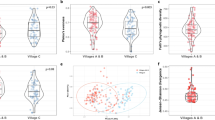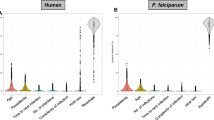Abstract
Recent studies indicate that urbanization is having a pronounced effect on disease patterns in developing countries. To understand the immunological basis of this, we examined mRNA expression in whole blood of genes involved in immune activation and regulation in 151 children aged 5–13 years attending rural, urban low socioeconomic status (SES) and urban high-SES schools in Ghana. Samples were also collected to detect helminth and malaria infections. Marked differences in gene expression were observed between the rural and urban areas as well as within the urban area. The expression of both interleukin (IL)-10 and programmed cell death protein 1 increased significantly across the schools from urban high SES to urban low SES to rural (P-trend <0.001). Although IL-10 gene expression was significantly elevated in the rural compared with the urban schools (P<0.001), this was not associated with parasitic infection. Significant differences in the expression of toll-like receptors (TLRs) and their signaling genes were seen between the two urban schools. Genetic differences could not fully account for the gene expression profiles in the different groups as shown by analysis of IL-10, TLR-2 and TLR-4 gene polymorphisms. Immune gene expression patterns are strongly influenced by environmental determinants and may underlie the effects of urbanization seen on health outcomes.
This is a preview of subscription content, access via your institution
Access options
Subscribe to this journal
Receive 6 digital issues and online access to articles
$119.00 per year
only $19.83 per issue
Buy this article
- Purchase on Springer Link
- Instant access to full article PDF
Prices may be subject to local taxes which are calculated during checkout



Similar content being viewed by others
References
WHO. Global Status Report on Noncommunicable Diseases 2010. World Health Organization: Geneva, 2011.
Rook GW . Hygiene hypothesis and autoimmune diseases. Clin Rev Allergy Immunol 2012; 42: 5–15.
Isunju JB, Schwartz K, Schouten MA, Johnson WP, van Dijk MP . Socio-economic aspects of improved sanitation in slums: a review. Public Health 2011; 125: 368–376.
Alirol E, Getaz L, Stoll B, Chappuis F, Loutan L . Urbanisation and infectious diseases in a globalised world. Lancet Infect Dis 2011; 11: 131–141.
Ibrahim MM, Damasceno A . Hypertension in developing countries. Lancet; 380: 611–619.
Swinburn BA, Sacks G, Hall KD, McPherson K, Finegood DT, Moodie ML et al. The global obesity pandemic: shaped by global drivers and local environments. Lancet 2011; 378: 804–814.
Dalal S, Beunza JJ, Volmink J, Adebamowo C, Bajunirwe F, Njelekela M et al. Non-communicable diseases in sub-Saharan Africa: what we know now. Int J Epidemiol 2011; 40: 885–901.
Popkin BM, Adair LS, Ng SW . Global nutrition transition and the pandemic of obesity in developing countries. Nutr Rev 2012; 70: 3–21.
WHO. Increasing Access to Health Workers in Remote and Rural Areas Through Improved Retention. WHO: Geneva, 2010.
Fezeu L, Balkau B, Kengne A-P, Sobngwi E, Mbanya J-C . Metabolic syndrome in a sub-Saharan African setting: central obesity may be the key determinant. Atherosclerosis 2007; 193: 70–76.
Delisle H, Ntandou-Bouzitou G, Agueh V, Sodjinou R, Fayomi B . Urbanisation, nutrition transition and cardiometabolic risk: the Benin study. Br J Nutr 2012; 107: 1534–1544.
Zeller T, Wild P, Szymczak S, Rotival M, Schillert A, Castagne R et al. Genetics and beyond–the transcriptome of human monocytes and disease susceptibility. PLoS ONE 2010; 5: e10693.
Cookson W, Liang L, Abecasis G, Moffatt M, Lathrop M . Mapping complex disease traits with global gene expression. Nat Rev Genet 2009; 10: 184–194.
Idaghdour Y, Storey JD, Jadallah SJ, Gibson G . A genome-wide gene expression signature of environmental geography in leukocytes of Moroccan Amazighs. PLoS Genet 2008; 4: e1000052.
Idaghdour Y, Czika W, Shianna K, Lee S, Visscher P, Martin H et al. Geographical genomics of human leukocyte gene expression variation in southern Morocco. Nat Genet 2010; 42: 62–67.
Koukounari A, Webster JP, Donnelly CA, Bray BC, Naples J, Bosompem K et al. Sensitivities and specificities of diagnostic tests and infection prevalence of Schistosoma haematobium estimated from data on adults in villages northwest of Accra, Ghana. Am J Trop Med Hyg 2009; 80: 435–441.
Medzhitov R . Toll-like receptors and innate immunity. Nat Rev Immunol 2001; 1: 135–145.
Hussaarts L, van der Vlugt LE, Yazdanbakhsh M, Smits HH . Regulatory B-cell induction by helminths: implications for allergic disease. J Allergy Clin Immunol 2011; 128: 733–739.
Maizels RM, Smith KA . Chapter 3—regulatory T cells in infection. In: Rudensky A, Sakaguchi S, (eds) Advances in Immunology; Volume 112. Academic Press, 2011, pp 73–136.
Kuningas M, May L, Tamm R, van Bodegom D, van den Biggelaar AH, Meij JJ et al. Selection for genetic variation inducing pro-inflammatory responses under adverse environmental conditions in a Ghanaian population. PLoS One 2009; 4: e7795.
May L, van Bodegom D, Frolich M, van Lieshout L, Slagboom PE, Westendorp RG et al. Polymorphisms in TLR4 and TLR2 genes, cytokine production and survival in rural Ghana. Eur J Hum Genet 2010; 18: 490–495.
Capron M, Capron A . Immunoglobulin E and effector cells in schistosomiasis. Science 1994; 264: 1876–1877.
Hartgers FC, Obeng BB, Kruize YCM, Duijvestein M, de Breij A, Amoah A et al. Lower expression of TLR2 and SOCS-3 is associated with Schistosoma haematobium infection and with lower risk for allergic reactivity in children living in a rural area in Ghana. PLoS Negl Trop Dis 2008; 2: e227.
Powell MJ, Thompson SA, Tone Y, Waldmann H, Tone M . Posttranscriptional regulation of IL-10 gene expression through sequences in the 3'-untranslated region. J Immunol 2000; 165: 292–296.
Rook GA . Regulation of the immune system by biodiversity from the natural environment: an ecosystem service essential to health. Proc Natl Acad Sci USA 2013; 110: 18360–18367.
van Riet E, Everts B, Retra K, Phylipsen M, van Hellemond J, Tielens A et al. Combined TLR2 and TLR4 ligation in the context of bacterial or helminth extracts in human monocyte derived dendritic cells: molecular correlates for Th1/Th2 polarization. BMC Immunol 2009; 10: 9.
Yi JS, Cox MA, Zajac AJ . T-cell exhaustion: characteristics, causes and conversion. Immunology 2010; 129: 474–481.
Rodriguez-Garcia M, Porichis F, de Jong OG, Levi K, Diefenbach TJ, Lifson JD et al. Expression of PD-L1 and PD-L2 on human macrophages is up-regulated by HIV-1 and differentially modulated by IL-10. J Leukoc Biol 2011; 89: 507–515.
Sakaguchi S, Miyara M, Costantino CM, Hafler DA . FOXP3+ regulatory T cells in the human immune system. Nat Rev Immunol 2010; 10: 490–500.
Grainger JR, Smith KA, Hewitson JP, McSorley HJ, Harcus Y, Filbey KJ et al. Helminth secretions induce de novo T cell Foxp3 expression and regulatory function through the TGF-beta pathway. J Exp Med 2010; 207: 2331–2341.
Xu L, Kitani A, Strober W . Molecular mechanisms regulating TGF-beta-induced Foxp3 expression. Mucosal Immunol 2010; 3: 230–238.
Lauener RP, Birchler T, Adamski J, Braun-Fahrländer C, Bufe A, Herz U et al. Expression of CD14 and Toll-like receptor 2 in farmers’ and nonfarmers’ children. Lancet 2002; 360: 465–466.
Kane CM, Cervi L, Sun J, McKee AS, Masek KS, Shapira S et al. Helminth antigens modulate TLR-initiated dendritic cell activation. J Immunol 2004; 173: 7454–7461.
Kawai T, Akira S . Toll-like receptors and their crosstalk with other innate receptors in infection and immunity. Immunity 2011; 34: 637–650.
Boef AGC, May L, van Bodegom D, Kuningas M, Eriksson UK, Westendorp RGJ . The influence of genetic variation on innate immune activation in an environment with high infectious pressure. Genes Immun 2012; 13: 103–108.
Beddow V ACCRA: sanitation status. IWA WaterWiki 2010, Available at http://www.iwawaterwiki.org/xwiki/bin/view/Articles/2)+ACCRA+(Ghana)+3.
Kormann MSD, Depner M, Hartl D, Klopp N, Illig T, Adamski J et al. Toll-like receptor heterodimer variants protect from childhood asthma. J Allergy Clin Immunol 2008; 122: 86–92.e8.
Kormann MSD, Carr D, Klopp N, Illig T, Leupold W, Fritzsch C et al. G-protein–coupled receptor polymorphisms are associated with asthma in a large German population. Am J Respir Crit Care Med 2005; 171: 1358–1362.
van den Biggelaar AH, Lopuhaa C, van Ree R, van der Zee JS, Jans J, Hoek A et al. The prevalence of parasite infestation and house dust mite sensitization in Gabonese school children. Int Arch Allergy Immunol 2001; 126: 231–238.
Koenig W, Sund M, Frohlich M, Fischer HG, Lowel H, Doring A et al. C-Reactive protein, a sensitive marker of inflammation, predicts future risk of coronary heart disease in initially healthy middle-aged men: results from the MONICA (Monitoring Trends and Determinants in Cardiovascular Disease) Augsburg Cohort Study, 1984 to 1992. Circulation 1999; 99: 237–242.
Barrett JC, Fry B, Maller J, Daly MJ . Haploview: analysis and visualization of LD and haplotype maps. Bioinformatics 2005; 21: 263–265.
Acknowledgements
We like to thank Dr Anita van den Biggelaar for advice and feedback on the manuscript. We would also like to thank Ms Mercy Geyi and Mr. Jonas Asigbee for assistance in parasitological sampling, Dr Marjolijn Duijvestein for assisting in mRNA measurements and Dr Martin Depner for polymorphism genotyping. We are most indebted to the study participants and their families, teachers, school authorities and community leaders. This work was supported in part by the Netherlands Foundation for the Advancement of Tropical Research (grant WB 93–443), the Netherlands Organization for Scientific Research, ZonMW TOP program (grant 912-03-048) and the European Commission (GA2LEN-FOOD-CT-2004-506378, GLOFAL-FOOD-CT-2005-517812 and EUROPREVALL-FOOD-CT-2005-514000).
Author information
Authors and Affiliations
Corresponding author
Ethics declarations
Competing interests
The authors declare no conflict of interest.
Additional information
Supplementary Information accompanies this paper on Genes and Immunity website
Rights and permissions
About this article
Cite this article
Amoah, A., Obeng, B., May, L. et al. Urban–rural differences in the gene expression profiles of Ghanaian children. Genes Immun 15, 313–319 (2014). https://doi.org/10.1038/gene.2014.21
Received:
Revised:
Accepted:
Published:
Issue Date:
DOI: https://doi.org/10.1038/gene.2014.21
This article is cited by
-
IgG1 Fc N-glycan galactosylation as a biomarker for immune activation
Scientific Reports (2016)



